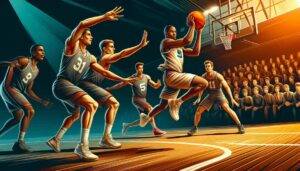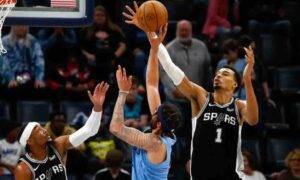Creating Scoring Opportunities in Basketball
Learn how to create scoring opportunities in basketball. Understand the different areas of the court, the importance of spacing, and master cutting, dribbling, passing, screening, and shooting. Maximize your chances and avoid turnovers.

In the fast-paced game of basketball, offense is the name of the game. It all comes down to creating those scoring opportunities near the basket or on the perimeter. Picture the court in your mind, with its different areas for offense: the top, slots, wings, corners, high posts, low posts, short corners, and key. To maximize your chances of scoring, good spacing between players is essential. But it's not just about positioning – you'll need to master the primary basic skills of cutting, dribbling, passing, screening, and shooting. Cutting takes advantage of the defense's focus on on-ball action, while dribbling allows you to advance the ball and break down defenders. Passing plays a crucial role in ball movement and creating high percentage shot opportunities. So grab your basketball and get ready to score big! Just watch out for violations like traveling, double dribble, and carrying, which can result in turnovers and loss of possession.
Areas on the Basketball Court
The basketball court is divided into various areas that play a significant role in offense. Familiarizing yourself with these areas will help you understand the offensive strategies and positions used in the game.
Top
The top of the basketball court refers to the area near the center line and the half-court line. This is a critical area where players often initiate offensive plays and set up their formations.
Slots
The slots are located on either side of the top area, between the three-point line and the key. These areas are commonly used by players to create opportunities for shooting, passing, and cutting.
Wings
The wings are the areas on the sides of the court, between the three-point line and the baseline. Players on the wings have the advantage of having multiple options, such as shooting, driving to the basket, or passing to a teammate.
Corners
The corners are the areas along the baseline, between the baseline and the three-point line. These spots are often utilized by players to create spacing and provide passing options to their teammates.
High Posts
The high posts are the areas near the free-throw line extended and the elbows of the key. These positions are frequently occupied by players who possess strong shooting skills and can also facilitate ball movement with their passing abilities.
Low Posts
The low posts are the areas closer to the baseline and the blocks of the key. These positions are often occupied by taller and more physically dominant players who excel in scoring close to the basket and grabbing offensive rebounds.
Short Corners
The short corners are located at the corners of the free-throw line and the baseline. These areas are occasionally utilized for baseline drives, shooting opportunities, or as passing outlets for players on the wing.
Key
The key, also known as the paint or the lane, is the rectangular area under the basket. It is a crucial area for players to position themselves for high-percentage shots, rebounds, and offensive maneuvers.
Importance of Spacing
Spacing plays a crucial role in basketball offense. It refers to the arrangement and positioning of players on the court, ensuring there is sufficient distance between them. Proper spacing offers several advantages for an offense.
Creating Openings for Drives
By maintaining proper spacing, offensive players can create opportunities to drive towards the basket. When players are spread out on the court, defenders are forced to cover more ground, creating gaps and openings for players to exploit and attack the basket.
Preventing Congestion near the Basket
Proper spacing prevents congestion near the basket, making it harder for defenders to collapse and double-team players who are close to scoring. When offensive players are adequately spaced out, it allows for better ball movement and the ability to kick the ball out to open shooters on the perimeter.
Opening Passing Lanes
Spacing also enables effective passing. When offensive players are well-distributed across the court, passing lanes open up, allowing for easier and more accurate passing. Good passing lanes facilitate quick ball movement, keeping the defense off balance and creating scoring opportunities.
Basic Offensive Skills
To excel in basketball offense, players need to develop and master a range of basic skills. These skills form the foundation of an effective offense and are essential for individual and team success.
Cutting
Cutting refers to the strategic movement of an offensive player without the ball, aiming to get open for a pass or scoring opportunity. By cutting, players can exploit the defense's focus on the on-ball action, creating openings and confusion for the defenders.
Dribbling
Dribbling is the act of bouncing the ball on the court while moving. It allows players to advance the ball, break down defenders, and penetrate into the paint. Good dribbling skills are essential for ball control, maintaining offensive flow, and creating scoring opportunities.
Passing
Passing is a fundamental offensive skill. Effective passing involves accurate and timely delivery of the ball to teammates, promoting ball movement, and creating open shots. It is crucial for finding teammates in scoring positions and exploiting defensive weaknesses.
Screening
Screening plays a significant role in offensive strategies. It involves an offensive player positioning themselves to block or impede a defender's movement, creating opportunities for the ball handler or a teammate to get open for a shot. Proper screening requires communication and precise timing.
Shooting
Shooting is perhaps the most visible offensive skill in basketball. It involves the ability to accurately and consistently score points by successfully shooting the ball into the basket. Strong shooting skills are essential for individual offensive success and contribute significantly to team performance.
Cutting as an Offensive Skill
Cutting is a crucial offensive skill that can have a tremendous impact on the game. It involves strategic movements by an offensive player without the ball, aiming to get open for a pass or scoring opportunity. Here's why cutting is an essential skill for offense:
Exploiting Defense's Focus on On-Ball Action
Defenses often focus their attention on the player currently in possession of the ball. By cutting, you can take advantage of the defense's fixation on the on-ball action. This diversion can create opportunities for quick passes and open opportunities near the basket, catching the defense off guard.
Creating Backdoor Opportunities
Cutting can be effective in creating backdoor opportunities. A backdoor cut occurs when an offensive player makes a quick, unexpected movement behind their defender toward the basket. Timing and communication with a teammate are crucial for successfully executing a backdoor cut, leading to easy scoring chances.
Moving Without the Ball
Cutting allows you to keep the defense guessing and constantly reposition yourself to receive passes or create scoring opportunities. By actively moving without the ball and making smart cuts, you become a valuable offensive threat and can help create spacing for your teammates.
Dribbling in Basketball
Dribbling is a fundamental skill in basketball that involves bouncing the ball on the court while moving. It is a critical offensive skill that serves various purposes:
Advancing the Ball
Dribbling allows you to move the ball up the court, initiating offensive plays, and finding scoring opportunities. It gives you control over the tempo of the game and enables you to set up plays or exploit defensive weaknesses.
Breaking Down Defenders
Dribbling is a skill that can be used to beat defenders one-on-one. By using a combination of quickness, ball handling, and change of direction, you can effectively break down defenders and create opportunities for yourself or your teammates.
Penetrating into the Paint
Dribbling skills are crucial for penetrating into the paint, the key area near the basket. By skillfully dribbling, you can navigate through defensive players, draw help defenders, and create scoring opportunities for yourself or open passing lanes to teammates.
Importance of Effective Passing
Passing plays a vital role in basketball offense. It involves delivering the ball accurately and timely to teammates, facilitating ball movement and creating scoring opportunities. Here's why effective passing is crucial:
Ball Movement
Passing is a primary means to facilitate ball movement on offense. By quickly and accurately passing the ball to teammates, you keep the defense on its heels and create opportunities to exploit defensive weaknesses. Continuous ball movement also forces defenders to adjust and expend energy, potentially leading to defensive breakdowns.
Creating Open Shots
Effective passing leads to the creation of open shots. By making accurate and well-timed passes, you can find teammates in positions where they have a higher chance of scoring. This includes passing to players who are open on the perimeter or making interior passes in situations where defenders are overcommitted.
Finding Teammates in Scoring Positions
Passing allows you to identify and deliver the ball to teammates who are in favorable scoring positions. By recognizing when a teammate has an advantage or a mismatch, you can make the right pass to maximize the scoring potential of your team. This requires court vision and awareness of your teammates' strengths and abilities.
Different Types of Passes
In basketball, there are different types of passes that players can utilize depending on the situation and defensive pressure. Here are some common types of passes:
Chest Passes
Chest passes involve delivering the ball from one player to another at chest level. This pass is typically used for quick and direct passes over shorter distances. It allows for a quick release and accuracy, making it effective for maintaining ball movement and finding open teammates.
Bounce Passes
Bounce passes involve bouncing the ball on the court to get it to a teammate. This pass is useful when defenders are closely guarding passing lanes or when the intended recipient is in motion. The bounce of the ball makes it more difficult for defenders to intercept, increasing the likelihood of a successful pass.
Overhead Passes
Overhead passes, also known as baseball or skip passes, involve throwing the ball over the defender from an overhead position. This pass is often used to quickly move the ball from one side of the court to the other, bypassing defenders and creating scoring opportunities on the weak side.
Common Violations to Avoid
Basketball has certain rules and violations that players need to be aware of to maintain possession and avoid turnovers. Here are some common violations to avoid:
Traveling
Traveling occurs when a player takes too many steps without dribbling the ball. In professional and collegiate basketball, a player is allowed a maximum of two steps after gathering the ball. Traveling results in a turnover, resulting in the opposing team gaining possession.
Double Dribble
Double dribble occurs when a player stops dribbling the ball and then begins dribbling again with both hands, or when a player dribbles with both hands simultaneously. This violation leads to a turnover, as only one dribble is permitted per possession.
Carrying
Carrying, also known as palming or a carry violation, occurs when a player gains an advantage by allowing the ball to rest or pause too long in their hand while dribbling. It is against the rules and typically results in a turnover, impacting the flow of the game.
Consequences of Violations
Basketball violations have consequences that can negatively impact the offensive team. The primary consequence of most violations is a turnover, resulting in the opposing team gaining possession of the ball. This can disrupt offensive flow, waste scoring opportunities, and potentially lead to counterattacks by the opposing team.
Turnovers can be detrimental to an offense's success and momentum. They not only result in lost scoring opportunities but can also lead to fast-break opportunities for the opposing team, increasing their chances of scoring. Therefore, minimizing violations and turnovers is crucial for maintaining offensive control and maximizing scoring potential.

